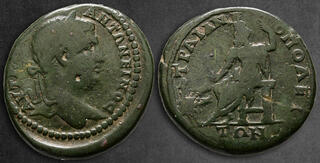| Savoca Numismatik GmbH & Co. KG > Online Auction 187 | Silver | Auction date: 10 December 2023 |
| Lot number: 118 Price realized: 50 EUR (Approx. 54 USD) Note: Prices do not include buyer's fees. | Show similar lots on CoinArchives Find similar lots in upcoming auctions on |
| Lot description: Thrace. Trajanopolis. Caracalla AD 198-217. Bronze Æ 31 mm, 17,18 g ΑΥΤ [Κ Μ ΑΥΡΗ] ΑΝΤΩΝΕΙΝΟC, laureate head right / ΤΡΑΙΑΝΟΠΟΛΕΙΤΩΝ, Hades-Serapis enthroned left, holding sceptre with left hand, right hand extended toward Kerberos. at his feet. Nearly Very Fine Varbanov 2820. Hades-Serapis stands as a fascinating example of religious syncretism during the Hellenistic and Roman periods, where the distinct realms of Greek and Egyptian mythology converged. This deity represents a blending of two significant figures: Hades, the Greek god ruling the underworld, and Serapis, a Hellenized form of the Egyptian deity Osiris-Apis. In Greek mythology, Hades is synonymous with the underworld and is a key deity among the Olympian gods. On the Egyptian side, Osiris-Apis is a divine entity associated with the afterlife, resurrection, and fertility. The synthesis of these two figures resulted in the creation of Serapis, a deity that incorporated elements from both cultural traditions. The rise of Hades-Serapis is closely tied to the cultural exchanges occurring in regions where Greek and Egyptian influences intersected. This syncretism served as a means to reconcile and amalgamate diverse religious practices. The cult of Serapis, including its syncretic form, gained significant popularity in Hellenistic Egypt and later within the broader Roman Empire. Hades-Serapis embodied characteristics related to the afterlife, death, and the agricultural cycle. Worship of this syncretic deity persisted into the Roman period, with temples dedicated to Serapis becoming prominent in various regions under Roman rule. However, with the ascendance of Christianity as the state religion of the Roman Empire, the cult of Serapis, including Hades-Serapis, faced a decline. The Christian influence led to the gradual abandonment of traditional polytheistic beliefs, marking a transformative period in the religious landscape of the ancient world. The story of Hades-Serapis underscores the dynamic nature of ancient religions, highlighting their ability to adapt and evolve in response to cultural encounters and influences. It stands as a testament to the rich tapestry of beliefs woven through the interactions of diverse civilizations in the Hellenistic and Roman eras. Starting price: 50 EUR |  |


